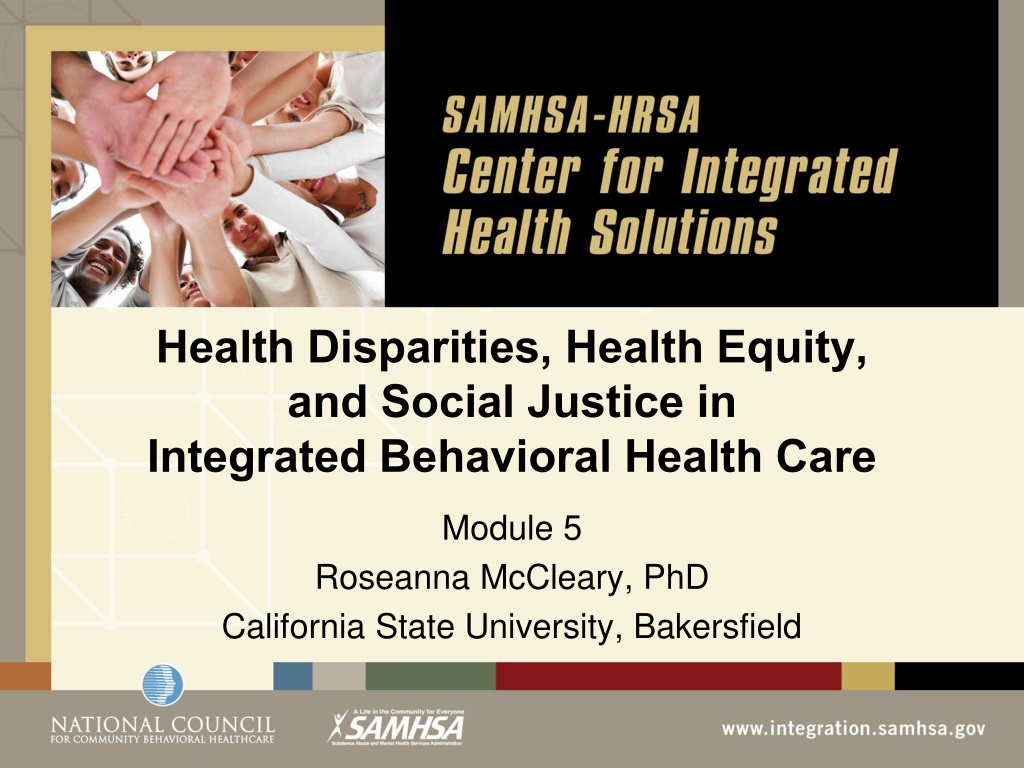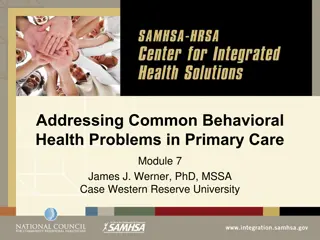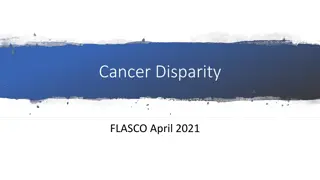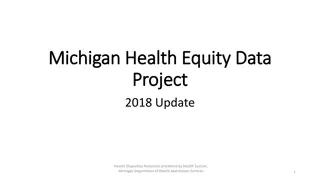Understanding Health Disparities and Equity in Behavioral Health Care
This module explores the significance of health disparities, health equity, and social justice within integrated behavioral health care. It delves into the role of addressing disparities, promotes ways to achieve equity in care models, and discusses the key organizations dealing with health disparity issues in the US. Definitions are provided to differentiate disparities in health from disparities in health care, emphasizing the importance of health equity.
Download Presentation

Please find below an Image/Link to download the presentation.
The content on the website is provided AS IS for your information and personal use only. It may not be sold, licensed, or shared on other websites without obtaining consent from the author. Download presentation by click this link. If you encounter any issues during the download, it is possible that the publisher has removed the file from their server.
E N D
Presentation Transcript
Health Disparities, Health Equity, and Social Justice in Integrated Behavioral Health Care Module 5 Roseanna McCleary, PhD California State University, Bakersfield
Learning Objectives 1. Increase knowledge of health disparities and health equity and the context in which they exist 2. Develop an understanding of the role of addressing health disparities in integrated behavioral care 3. Explore ways to address health disparities and promote health equity in integrated behavioral care models
Who deals with health disparity issues in the US? National Institute of Minority Health and Health Disparities (NIH) Office of Minority Health (DHHS) Federal Collaboration on Health Disparities Research (DHHS) Office of Minority Health and Health Disparities (CDC) Office of Behavioral Health Equity (SAMHSA) Office of Health Equity (HRSA)
Definitions How health disparity and health equity are defined affects how a policy is conceptualized For policy purposes, need to distinguish among: Disparities in health Disparities in health care Health equity Health inequalities
Definition: Disparities in Health Differences in the incidence, mortality, and burden of disease and other adverse health conditions that exist among special population groups in the United States 1 Differences in health that are not only unnecessary and avoidable, but, in addition, are considered unfair and unjust 2
Definitions: Disparities in Health Care Differences in the quality of health care that are not due to access-related factors or clinical needs, preferences, or appropriateness of intervention. 3 Should policymakers focus on disparities in health or disparities in health care?4
Defining Health Equity Equity in health implies that ideally everyone should have a fair opportunity to attain their full health potential . . . No one should be disadvantaged from achieving this potential 5 Equity in health care requires that resource allocation and access to health care be determined by health needs 6
Why is it Important to Define These Terms? Should mental and substance use disorders treatments be integrated into general health policy? E.g., Mental Health and Substance Abuse Parity Or should they be treated as exceptions? E.g., carve-outs? Which of the previous definitions best reflects a social justice perspective?
The Face of Health Disparities: Brianna Brianna is a 9 year old African-American female who is admitted to the pediatrics unit for respiratory failure related to undiagnosed asthma Brianna receives almost all of her medical care from emergency room and urgent care visits She lives at home with her mother and 2 siblings Brianna s mom works as a clerk at a construction company and earns $29,232 a year; she cannot afford to pay for the additional health insurance fees for her 3 children and has become increasingly depressed due to numerous stressors
The Face of Health Disparities: Maria Maria, 81, recently had a stroke and also has diabetes and high blood pressure; she relies on a wheelchair, and needs help with her activities of daily living Maria came to the US when she was in her 20 s from the Mexican state of Oaxaca and worked in agriculture until she retired at age 65 She relies on her family for her care, however, when one of her daughters lost her job, Maria had to use what little savings she had to cover costs Her family doesn't know how they will continue to pay for and manage Maria s care
Health Disparities: The Context Health disparities are connected to a social context that includes individual, socioeconomic, and political factors which determine health outcomes7 Historically social policy has contributed to health disparities Factors may include housing, neighborhood, access to work and educational opportunities, individual lifestyle (age, gender), socioeconomic status, and access to health care Evidence shows that health disparities among particular racial and ethnic groups have multiple causes that need to be addressed on multiple levels Describe Brianna s and Maria s contexts and how they have lead to health disparities
Examples of Health Disparities in Mental Health Children from racial/ethnic minority groups are 1/3 to 1/2 less likely to receive necessary mental health treatment than White children, despite similar prevalence rates8 Only 1 in 11 Latinos with a mental health disorder contacts a mental health provider and 1 in 5 contacts a general health care provider9 LGBT adults have higher rates of smoking, alcohol and drug use, suicide, and depression10
More Examples of Health Disparities in Mental Health Hispanic Americans (except those from Puerto Rico), Asian Americans, and Black Americans have a lower incidence of mental disorders than White Americans The Latino or Hispanic paradox Hispanic populations have lower rates of illness, but the more time someone from Mexico, Africa, or the Caribbean spend in the US, the higher the rate of disorders American Indians are at higher risk for PTSD and alcohol dependence, but at lower risk for depression11
How Do We Measure Health Disparity?12 Life expectancy, infant mortality, rate of chronic diseases differences among ethnicities Health care what is recommended and what is available or delivered Access to care barriers Geographic and provider-level differences Availability of culturally-sensitive, trained, bilingual mental health professionals
Causes of Disparities in Mental Health and Substance Use Disorders Lack of insurance Geographic and provider-level differences Poor access Low quality of care Health provider assumptions, discrimination Language barriers Mental health workforce disparities
Approaches to Reduce or Eliminate Health/Health Care Disparities Address social disparities (e.g., poor housing, low education, poverty, lack of job opportunities) Improve access to care Provide incentives to health care professionals for improving communication, providing appropriate screening and treatment Increase racial and ethnic diversity in the mental health care workforce to reflect community populations
An Example of an Integrated Model of Care Addressing Health Disparities An organization that addresses health disparities is: Culturally and linguistically competent, Responsive to the community, Resides in a reasonable location, Has flexible hours of operation , and Committed to addressing social determinants of health disparities (e.g., health literacy, socioeconomic status, housing) See handout for schema14
Equity in Mental and Substance Use Disorders Health Care Policy Mental Health Parity Act of 1996 9 USC 1185a - Parity in mental health and substance use disorder benefits Olmstead v. L.C, 527 U.S. 581 (1999) People have a right to live in the community in the least restrictive environment Paul Wellstone and Pete Domenici Mental Health Parity and Addiction Equity Act of 2008 Expanded MHPA to include substance abuse treatment Pending in Congress S. 2474: Health Equity and Accountability Act of 2012 introduced by Senator Akaka
Health Disparities and the Patient Protection and Affordable Care Act There are numerous provisions in the PPACA that address reducing health disparities and increasing health care equity These fall under six domains: Consistent data collection Workforce diversity Cultural competence training and education Funding health disparities research Prevention program promotion Addressing disparities in health insurance reform
PPACA and Integration ACA has a number of provisions to integrate primary and behavioral health care SAMHSA states that: For consumers of mental health services or those in recovery from addiction disorders, the law s provisions and the general movement toward integration are important steps that can lead to improved overall health 13 How do the 6 domains address health disparities and how can they be incorporated into integrated care models? Discussion: How does your county mental health and public health agencies address these 6 domains, and what models of integrated behavioral health care are being implemented?
Achieving Health Equity for All an Organizational Model for Change How does an agency address health disparity issues and ensure that those it serves gets equitable health care? Key step is an organizational self assessment to determine which issues need to be addressed, the organization s ability to address these issues, and its readiness to implement changes The Bay Area Regional Health Inequities Initiative (BARHII) toolkit for organizational self-assessment is one collaborative model that shows how one community is dealing with their health inequities14
BARHII Organizational Assessment Organizational Characteristics and Workforce Competencies15 Organizational Characteristics Institution/agency s commitment to addressing health inequities Willingness to hire A structure that will support collaborations/partnerships Staff support Transparent communication Creative use of categorical funds Community-accessible data and planning A smooth administrative process Workforce Competencies Passion, self-reflection, and listening skills Knowledge of a public health framework Able to integrate social, environmental, and structural determinants of health Knowledge of the community/Leadership skills Ability to collaborate/Community organizing skills Problem solving skills/Cultural sensitivity
Additional Models for Organizational Self Assessment National Center for Cultural Competence, Innovative self assessment and strategic planning - focus on cultural and linguistic competence (http://nccc.georgetown.edu/documents/Contra%20Costa.pdf) State of New Jersey, Department of Health and Human Services Health Disparities Self Assessment (http://www.state.nj.us/health/omh/documents/2009self_assessme nt_survey_report.pdf) Developing a Self Assessment Tool for CLAS in Local Public Health Agencies (http://www.minorityhealth.hhs.gov/assets/pdf/checked/LPHAs_Fi nalReport.pdf)
Health Equity Beyond Race and Ethnicity Disparities exist in other populations Older adults Higher rates of suicide The LGBT community (in particular, older adults) Access to health care Higher rates of smoking, alcohol and drug use, suicide and depression Persons who live in rural areas Lack of healthcare professionals, specialists High poverty levels
Implications for Social Work Culturally sensitive practice is crucial when dealing with health disparities Awareness of the causes of health disparities is needed in order to advocate for vulnerable populations By dealing with health disparities, the goal of health equity can be realized
References National Institutes of Health. (2009). Biennial Report of the Director. Retrieved from http://report.nih.gov/biennialreport/ViewSection.aspx?sid=26&cid=4 Whitehead, M. (1992). The concepts and principles of equity and health. International Journal of Health Services, 22, 429-445. Stith AY, Nelson AR. (2002). Committee on Understanding and Eliminating Racial and Ethnic Disparities in Health Care, Board on Health Policy. Institute of Medicine. Washington, DC: National Academy Press. Smedley, B.D. (2006). Expanding the frame of understanding health disparities: from a focus on health systems to social and economic systems. Health Education and Behavior, 33(4):538-41. Whitehead, M. (1992). The concepts and principles of equity and health. International Journal of Health Services, 22, 429-445. Aday, LA, Fleming, GV, Anderson, RM. (1984). An overview of current access issues. In Anderson, R. and Aday, LA. Access to medical care in the US (pp. 1-18). Chilcago, IL: Pluribus Press/University of Chicago. Stratton, A., Hynes, M., Nepaul, A. (2007). Issue brief: Defining health disparities. The Connecticut Health Disparities Project. Connecticut Department of Public Health. Retrieved from http://www.ct.gov/dph/lib/dph/hisr/pdf/defining_health_disparities.pdf National Institute of Allergy and Infectious Diseases. (2001). Minority health: What are mental disparities? Retrieved August 1, 2012 from http://www.niaid.nih.gov/topics/minorityhealth/pages/disparities.aspx National Council of La Raza, 2006 Movement Advancement Project. (2007, September). LGBT older adults and health disparities. Retrieved from http://www.lgbtmap.org/file/lgbt-older-adults-and-health-disparities.pdf Miranda, J, McGuire, TG, Williams, DR, Wang, P. (2008). Mental health in the context of health disparities. The American Journal of Psychiatry, 165(9). Miranda, J, McGuire, TG, Williams, DR, Wang, P. (2008). Mental health in the context of health disparities. The American Journal of Psychiatry, 165(9). Substance Abuse and Mental Health Services Administration. (2011). Why is the Affordable Care Act important for people with health disparities? (SMA11-HR006). Rockville, MD. 1. 2. 3. 4. 5. 6. 7. 8. 9. 10. 11. 12. 13.
References 14. Sanchez, K. Chapa, T., Ybarra, R., Martinez, O. N. (2012). Enhancing the delivery of health care: Eliminating health disparities through a culturally and linguistically centered integrated health care approach. Hogg Foundation for Mental Health. Retrieved from http://www.hogg.utexas.edu/uploads/documents/FinalReport%20-ConsensusStatementsRecommendations.pdf 15. Bay Area Health Inequities Initiative (2010). Organizational self assessment for addressing health inequities. Toolkit and guide to implementation. Oakland, CA; BARHII. Retrieved from: http://www.barhii.org/resources/downloads/self_assessment_toolkit.pdf.























